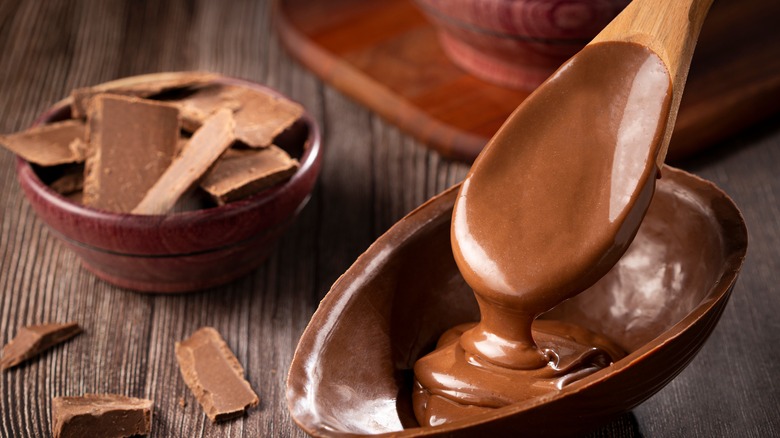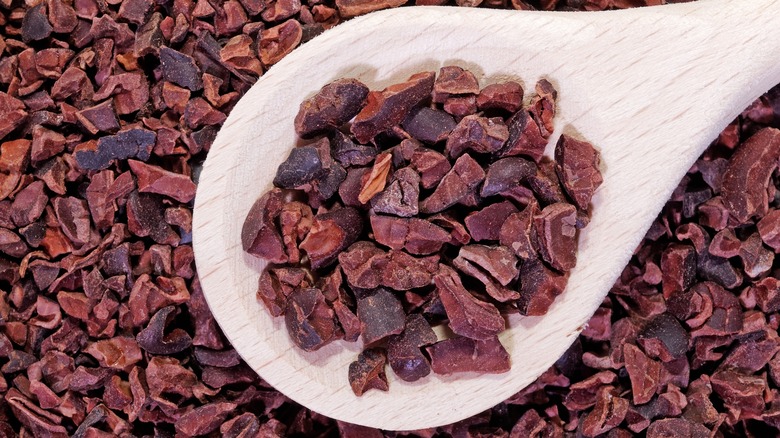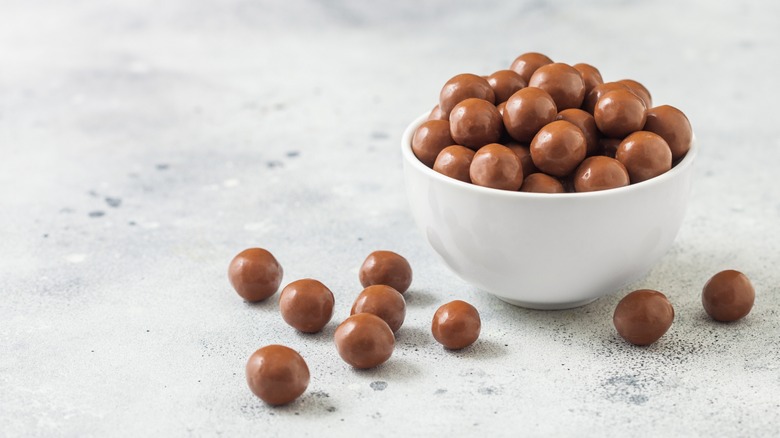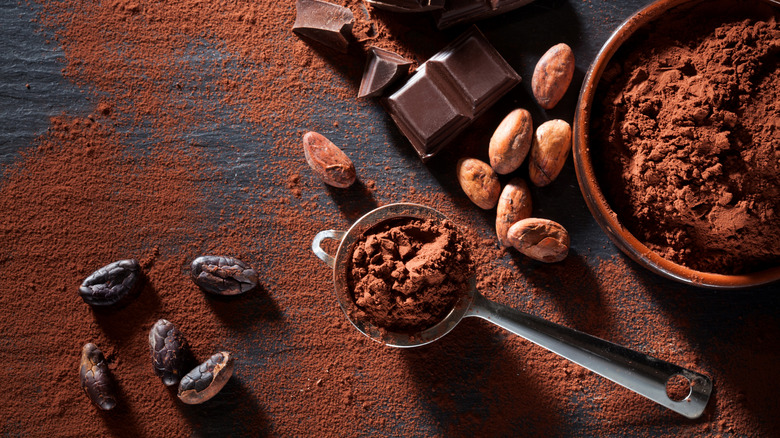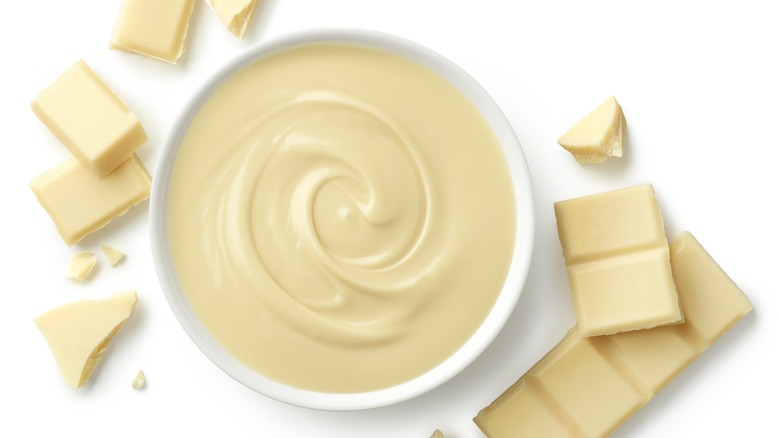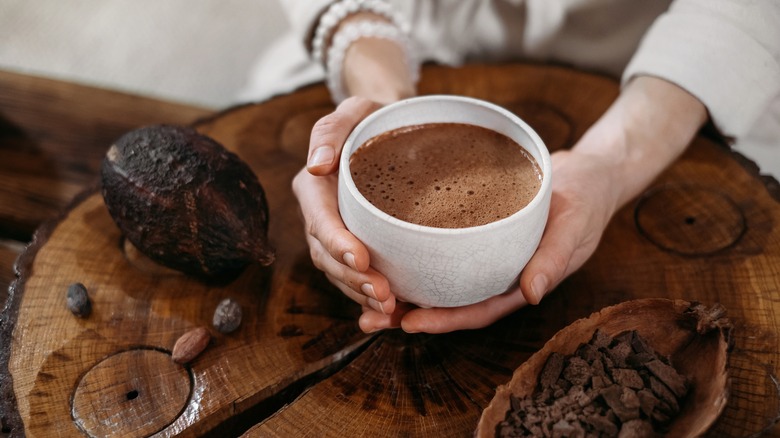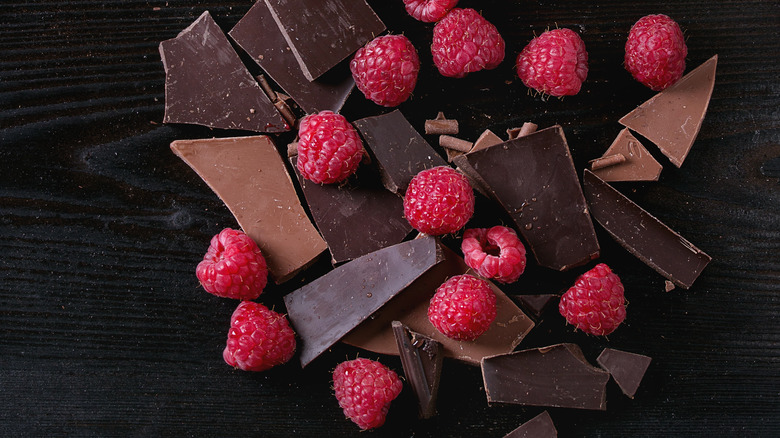The Best Ways To Eat Chocolate And Which To Avoid
Here's some good news for you: Chocolate is a superfood. In fact, in a 2011 study, cocoa powder and dark chocolate were found to have the highest content of cancer-fighting antioxidants compared to other well-known antioxidant-rich foods like acai and blueberries. Cocoa powder is also a dense source of nutrients, including fiber, protein, and iron (via My Food Data).
But before you go raiding the pantry for your secret chocolate stash, you should know that many chocolate products have some serious drawbacks (per the British Heart Foundation). Although they may contain beneficial cocoa, they often also contain high amounts of calories, fat, and sugar. And, the cocoa used is often heavily processed, which removes much of nutrients and health benefits, according to a mini-review published in Frontiers in Immunology. That said, you can still enjoy chocolate, but you need to be aware of what types of chocolate are actually good for you and which types can hurt your health. Here are some of the healthier ways you can consume chocolate, and some others you should avoid.
What is chocolate?
Chocolate comes from the cacao bean, which is the seed of the fruit of the Theobroma cacao tree. The natural product before processing is referred to as cacao. After processing, it's referred to as cocoa. You can find minimally processed raw cacao nibs and raw cacao powder, often in specialty health food stores. According to the BBC, to make cacao into chocolate, the beans are fermented, dried, and then roasted to develop the flavor. The roasted beans are cracked and the shells are removed in a process called winnowing, leaving behind the dense core, called the nib. The nibs can be eaten whole or they can be ground down into cocoa powder.
Many chocolate confections bear little resemblance to cocoa. Once in nib and powdered form, the cocoa is processed, typically with heat, to change the texture and form of the chocolate. For example, tempering chocolate means heating it slowly and then letting it cool. This evenly crystalizes the fats for a smooth finish. Heating the chocolate destroys some of its nutrient content (via Frontiers in Immunology). Other ingredients — including milk, cream, caramel, candies, and more – are often added to chocolate products and further dilute the nutritional content. Sugar is an ingredient often added to make chocolate taste sweet and cut the bitterness of the cocoa (via Everyday Health). Large amounts of sugar negate any health benefits chocolate may have, according to The New York Times.
Eat: raw cacao nibs
One ounce of raw, unadulterated cocoa nibs contains 170 calories and provides 30% of the daily value (DV) for fiber, 8% of the DV for protein, and 0 grams of sugar (via My Food Data). Raw cocoa is high in fat, though, with 35% of the DV for saturated fat. Too much saturated fat can raise your "bad" LDL cholesterol and increase the risk of heart attack and stroke (via the American Heart Association). However, according to Yale New Haven Health, the saturated fat in cocoa is not as bad for you as the saturated fat in animal products. This is because a third of the saturated fat comes from stearic acid, which does not affect LDL levels. With its high fiber content, raw cocoa can boost heart health, because fiber helps remove excess cholesterol from the body (via the Mayo Clinic).
Cocoa nibs can be used to add a hint of chocolate flavor to many different sweet and savory dishes (via Healthline). On their own, cocoa nibs have a fairly strong and bitter flavor, but when you add them to foods, their flavor becomes more balanced. Try adding them to smoothies, baked goods, savory sauces, homemade trail mix, nut butters, granola, or using them as a topping on oatmeal or yogurt. You'll get that chocolatey satisfaction without all the sugar and with a bounty of health benefits.
Avoid: milk chocolate
Dark chocolate doesn't contain milk (via My Food Data). True to its name, milk chocolate does contain milk and other dairy products. While there's nothing inherently wrong with that, the addition of dairy causes further dilution of the cocoa's nutrients and accompanying health benefits. For example, while an ounce of 70% to 85% dark chocolate provides 11% of the DV for fiber and 19% of the DV for iron, the same amount of milk chocolate only provides 3% of the DV for fiber and 4% of the DV for iron. Dark chocolate also contains about double the amount of potassium, more than three times as much magnesium, and four times as much copper and manganese. In addition, milk chocolate has a lot more sugar, with more than double the amount in dark chocolate.
And, if you're trying to lose weight, eating dark chocolate instead of milk chocolate may be helpful despite the fact that dark chocolate tends to be higher in calories (via Harvard T.H. Chan School of Public Health). In a study published in 2011 in Nutrition & Diabetes, study participants who ate dark chocolate felt more satiated, had less desire for sweet foods, and consumed fewer calories than participants who ate milk chocolate.
Eat: raw cacao powder
Cacao powder offers the same benefits as eating raw cacao nibs. In fact, it's an even richer source of some nutrients. One ounce of raw cacao powder contains 25% of the DV for fiber, 14% of the DV for protein, 11% of the DV for phosphorus, and 28% of the DV for iron. Ounce for ounce, raw cacao powder offers more fiber, protein, and iron than beef, spinach, and lentils. And it has no added sugar (via My Food Data).
You can use cacao powder in similar ways as cacao nibs. Powder won't have the same crunchy texture as the nibs, which makes it ideal for blending into smoothies, yogurt, or nut butters (via The Upside). You can also use 100% raw cacao powder to make your own chocolate confections. This way you can control the amount of sugar you include, or use a sugar substitute, and you can add in other healthy ingredients such as nuts and seeds (via Chocolate Covered Katie).
Avoid: white chocolate
Did you know white chocolate isn't even chocolate? It contains no cocoa solids, hence its lack of dark pigmentation (via Penn State Extension). White chocolate contains no fiber or iron, and compared to both milk and dark chocolate it has more sugar and less of nutrients such as protein, potassium, magnesium, and phosphorous (via My Food Data). It's also devoid of the antioxidant compounds of which dark chocolate is such a rich source (via Penn State Extension). Aside from a little extra calcium from the dairy content, white chocolate offers no meaningful health benefits (via SFGate).
If you really can't live without white chocolate, try to eat it infrequently and in small amounts. You can also look for sugar-free white chocolate — or make your own — made with stevia or another natural sugar substitute. Your white chocolate still won't be healthy, but at least it won't be a sugar bomb.
Eat: dark chocolate bars
Raw cacao is healthy and tasty, but it's not quite the same thing as a chocolate bar. When you're craving a chocolate treat, dark chocolate is the healthiest choice. Whereas raw cacao contains 100% cocoa solids (pure cacao), dark chocolate contains anywhere from 50-90% cocoa solids (via Harvard T.H. Chan School of Public Health). The other portion is made up of added sugar and cocoa butter, which is a plant-based fat extracted from the cacao bean. Cocoa butter is also used to make cosmetics and pharmaceuticals (via Healthline). The lower the content of cocoa solids, the lower the nutrient density. Therefore, you should choose a dark chocolate with a high percentage of solids. Harvard Health recommends a minimum of 70%.
Keep in mind that the higher the solids content, the stronger and more bitter the chocolate will taste. But it will also be a richer source of antioxidants and other nutrients. Ounce for ounce, 70-85% dark chocolate contains more fiber, protein, iron, calcium, and potassium and less sugar than 60% dark chocolate (via My Food Data). Choosing a darker chocolate may also boost your mood. A 2022 study in The Journal of Nutritional Biochemistry found that people who ate chocolate containing 85% cocoa solids had a better overall mood than people who ate chocolate with 70% solids or no chocolate at all.
Avoid: candy bars
For the same reason you should choose milk over dark chocolate and pass on white chocolate, you may also want to skip chocolate candy bars. The chocolate in candy bars is typically highly processed, and candy bars can contain many other unhealthy ingredients besides chocolate, such as artificial colors and flavors, high fructose corn syrup, and preservatives. Perhaps the biggest problem is all the added sugar. One candy bar may contain 40 grams of added sugar (via My Food Data). According to the American Heart Association, the maximum amount of sugar you should consume in a day is 25 grams for women or 36 grams for men. So, that single candy bar indulgence will provide more than the daily recommended limit. Eating too much sugar can have deleterious effects on your health, including an increased risk of obesity, which can influence the development of chronic conditions including high cholesterol, high blood pressure, and diabetes (per Johns Hopkins Medicine). Excess sugar also contributes to chronic inflammation which has been linked to heart disease and even cancer (via Harvard Health Publishing and the National Cancer Institute).
Eat: small amounts, mindfully
One of the best methods to feel satisfied with smaller amounts of food is called mindful eating — and it's the perfect strategy for enjoying chocolate but keeping it healthy. This practice involves staying aware and focusing on the present moment, paying attention to the sensations, tastes, and smells of what you're eating (via Diabetes Spectrum). This style of eating is intended to help you savor every bite and to increase the satisfaction you feel while eating.
Here's how to do it with dark chocolate, according to James Madison University. You begin the sensory experience by holding the wrapped chocolate in your hand. Feel its weight and shape. Notice the packaging, the colors, the feel of the material. Begin to unwrap the chocolate, listening to the sounds the packaging makes. Focus only on this task, not on any other sounds or sights outside of the chocolate. If you get distracted, simply return your focus to the chocolate. Bring the chocolate to your nose and slowly inhale and exhale through your nose several times, noting all the different aromas. Next, take a small bite of chocolate, but don't chew it yet. Hold it in your mouth, feeling the texture and noticing the tastes and sensations in your mouth. Move the chocolate around in your mouth, then slowly swallow the chocolate and notice any lingering flavors or textures. Do this same thing again with another small bite. Stop when you have eaten one square of chocolate.
Avoid: store-bought hot cocoa
There's nothing better than a cup of hot cocoa on a cold afternoon. However, if the store-bought so-called "hot cocoa" is your go-to, it's not doing your health any favors. For instance, consider Swiss Miss milk chocolate hot cocoa's ingredients list: sugar, corn syrup, modified whey, cocoa (processed with alkali), hydrogenated coconut oil, and nonfat milk, with small amounts of salt, preservatives, and natural flavorings. Many of these added ingredients are ones you may want to avoid. And while it contains some cocoa, cocoa processed with alkali is not the same as pure, unprocessed cocoa powder. Also known as Dutch processing, alkalization of cocoa powder changes its flavor and color and increases its solubility so it dissolves better in liquid (via Comprehensive Reviews in Food Science and Food Safety). However, it also increases its pH level, which destroys the content of health-promoting antioxidant compounds (via Journal of Agriculture and Food Chemistry).
The good news is that you can enjoy a healthier, delicious hot chocolate at home by making it yourself with raw cocoa powder (via Simply So Healthy). In a small saucepan, whisk together 1 tablespoon of raw cocoa powder and your choice of sugar or sugar substitute (stevia, erythritol). Whisk in 1 cup of milk — dairy or unsweetened plant-based — and heat until steaming. Do not allow to boil. Turn off the heat and stir in 1/3 teaspoon of vanilla extract.
Eat: fruit topped with dark chocolate
The U.S. Department of Agriculture (USDA) recommends adults have 1.5 to 2.5 cups of fruit each day, but most people don't eat enough (via The Washington Post). As with vegetables, fresh fruit is packed with vitamins, minerals, fiber, and antioxidant nutrients that safeguard your health and help prevent disease. Per the Harvard T.H. Chan School of Public Health, a diet rich in fresh produce can help lower your blood pressure and your risk of heart disease and stroke, prevent certain forms of cancer, reduce the risk of eye and digestive problems, and help control blood sugar. It can also help control your appetite so you can more easily maintain your weight or lose weight.
You can use dark chocolate to add taste appeal, turn fruit into a decadent dessert, and bring a boost of antioxidants to your bowl. Simply melt a bar of 70-85% dark chocolate and use it as a drip or dip for your fresh fruit (per So Fab Food). Be ready to have your taste buds wowed! You can choose any type of fruit you like, but fresh berries are particularly potent sources of nutrition (via Harvard T.H. Chan School of Public Health). You can also add these ingredients to a bowl with 1/4 cup of plain Greek yogurt for a rich, creamy kick of protein (via The University of Tennessee Medical Center).
Avoid: eating chocolate at night
A square or two of rich dark chocolate makes the perfect after-dinner treat. But if you're sensitive to caffeine, stay away — or you might be staying awake. According to ConsumerLab.com, dark chocolate provides 40-50 mg of caffeine per serving, which is about the amount of caffeine in a cup of black tea, double the amount of a cup of green tea, and about half the amount you'd find in a cup of brewed coffee (via the Mayo Clinic). The darker the chocolate, the higher the caffeine content. Cocoa powder is lower in caffeine, with about 8-20 mg of caffeine per serving, but that's still enough to stimulate the caffeine-sensitive.
Too much caffeine too close to bedtime can make it hard not only to drift off, but also to stay asleep and get restful sleep (via Sleep Foundation). Insufficient sleep is already a global public health epidemic, according to a 2019 article in Healthcare, and about a third of American adults aren't getting enough, notes the Centers for Disease Control and Prevention (CDC). Don't sacrifice sleep for a sweet treat. The Sleep Foundation recommends you avoid products with caffeine for about six hours before bed. If you have a nighttime craving for sweets, try some dried or fresh fruit instead (per Healthline).


